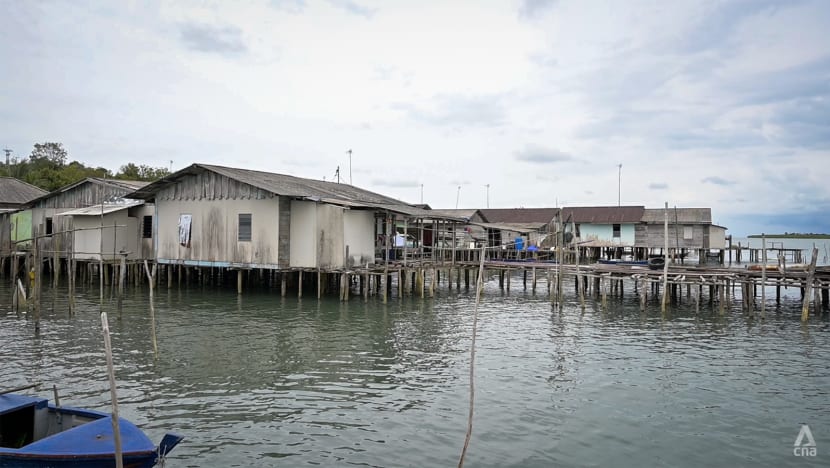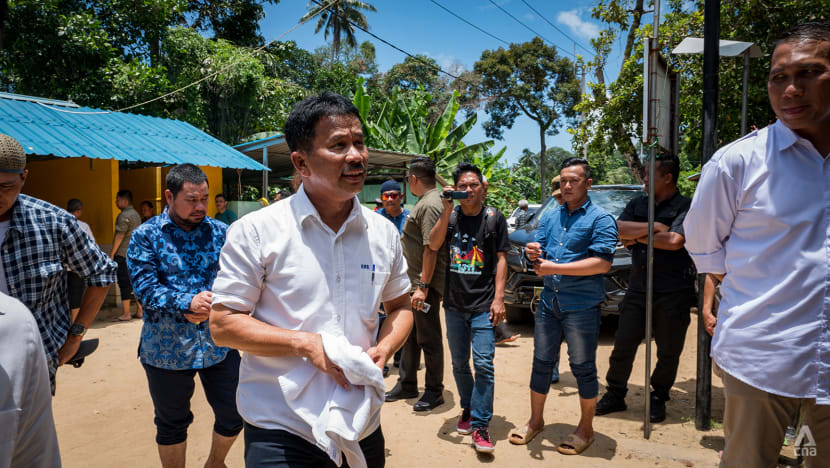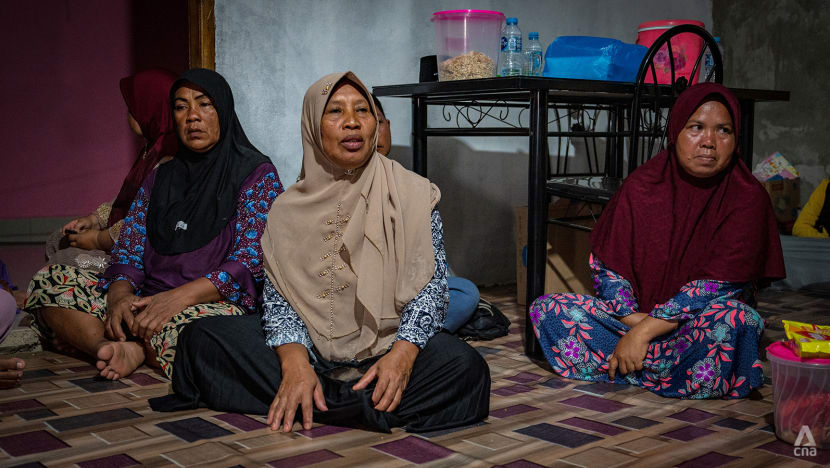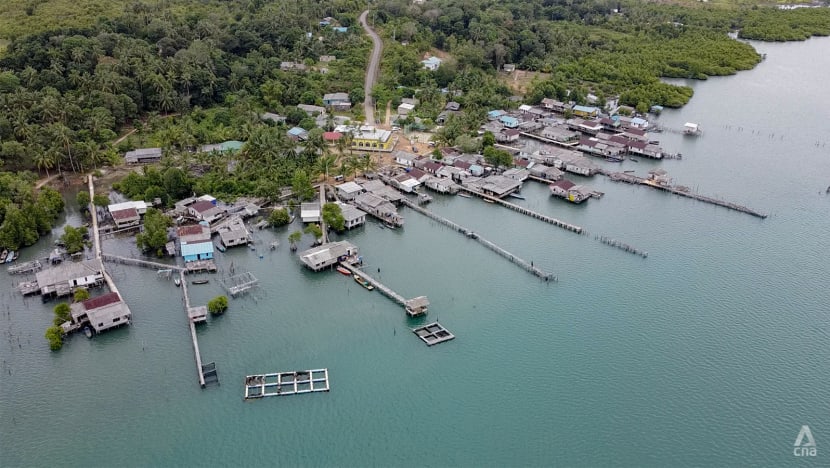'Just let me die here': Why locals on Indonesia's Rempang oppose eviction for China-backed project
The Indonesian government wants to develop Rempang into an eco-city that will pull in some US$26.6 billion in investment, but some 7,500 villagers oppose having to leave their ancestral land.

Most residents of Rempang are fishermen. (Photo: CNA/Danang Wisanggeni)
REMPANG, Indonesia: Mdm Zaitun, 81, a member of the indigenous Malay tribe on Rempang island, has been restless for the past couple of weeks.
She cannot sleep well nor eat properly out of fear she soon must leave her beloved home in the Pasir Panjang village on Rempang, which is located southeast of Batam that in turn is less than an hour's ferry journey from Singapore.
In late August, the Indonesian government decided some 7,500 Rempang islanders had to leave their homes immediately for a new economic zone on the island that has been earmarked to pull in some US$26.6 billion in investment by 2080.
It will also house a quartz sand processing plant by Xinyi Glass, a giant Chinese company and the world’s largest producer of glass and solar panels.
The thought of leaving her village scares Mdm Zaitun, who was born on the island and has spent her entire life there.
“I’m sad. It’s like my heart is being cut,” the great-grandmother of five told CNA. “I want to cry, but I’ve run out of tears.”
Mdm Zaitun, who goes by one name, is not the only islander who opposes the government’s plan.

The majority is against it, leading to violent protests on Sep 7 and Sep 11, which saw demonstrators throwing stones and molotov cocktails and the military and police firing tear gas in return.
The government claims the villagers, who include the Orang Darat tribe and are mostly indigenous Malay fishermen, will be compensated if they leave the island.
Each of the some 900 affected families will get 500 sq m parcel of land with a house valued at 120 million rupiah (US$7,700).
But the land and houses are not yet ready, which meant the islanders were told to move to flats in Batam - about an hour's drive away from Rempang - where it would be hard for them to fish in the sea.
The case has sparked criticism of how the government evicts villagers, mostly indigenous people, in the name of economic development and projects.
Analysts say the government is violating human rights and is only acting in the interests of business owners and oligarchs, with the Rempang case being one of several other controversial examples under President Joko Widodo’s administration.
WHAT IS THE REMPANG PROJECT?
The government wants to build an eco-city on Rempang.
It will be a joint project between the Batam Indonesia Free Zone Authority (BP Batam), which Rempang is under, and private Indonesian company PT Makmur Elok Graha (MEG).
MEG is owned by business conglomerate Tomy Winata who, among others, owns Jakarta’s renowned Sudirman Central Business District where the Indonesia Stock Exchange is situated.
The eco-city project will span some 17,000 hectares and entail industrial estates and tourism areas on Rempang, including Xinyi Glass, which wants to pour US$11.6 billion into the factory.

Minister of Investment Bahlil Lahadalia said the project will create about 35,000 jobs.
The project has been in the making since 2004, but villagers only learned in end-August that they had to leave their ancestral land.
Some were approached by officers who did not clearly identify themselves, while some heard it through word of mouth, said villager Mdm Saerah, 63, who goes by one name.
“Their explanations were never clear. One day, they said A, and the following day B. So we are confused: whose statements can we hold on to?” she told CNA.
“They told us they want to build a Chinese glass project to prosper the people, especially us Rempang people. But if they want us to prosper, why must they torture us by forcing us to leave?”

WHY REMPANG?
Rempang is rich in quartz sand, a material that can be used for making solar panels.
Mdm Saerah claimed their ancestors have lived on the island for hundreds of years, and they mostly have their own houses and land where they grow plants for daily consumption.
Islanders were initially told to leave the island by Sep 28, with construction due to begin next year.
However, since many are resistant, the government has decided to do its best to convince them until the islanders agree to be relocated, Mayor of Batam Muhammad Rudi, who is also the head of BP Batam, told CNA.
For instance, no new date has been announced after the Sep 28 eviction date lapsed, and residents have been promised that they would be moved to other locations on Rempang, and not off the island completely.
Mr Rudi visited Rempang and met a few islanders on Sep 21. It was his first visit to the island since the news broke that the islanders had to move.

CNA saw how Mr Rudi tried to persuade villagers to agree to the relocation during a recent visit to Rempang.
He was accompanied by officials from the police, military, and the head of Batam’s district prosecutor's office, who also tried to convince the locals to move. But their attempts were in vain.
Mdm Saerah said they are not against economic development as long as they do not need to move.
“We don’t want to move because this is our Malay way of life. If we leave, our identity will be lost,” she highlighted.
“Why does the government want to erase our traditional way of life for the sake of foreigners?”

She said she has many other questions, and that the government's answers have been inadequate and inconsistent.
“The project has apparently been in the making since 2004. Why have they only told us about it now?” Mdm Saerah added.
“And why have they not prepared the land where we must move to? They could have prepared the new housing for us last year or two years ago before telling us to move.”
The deal between Indonesia and Xinyi was only closed at the end of July when President Widodo met Chinese President Xi Jinping in China.
The memorandum of understanding (MoU) was signed on July 28.
This is the reason why Rempang islanders suddenly have to move, said Mr Rudi.
He added that the investor and the government have agreed on the location and the project's timeline.
“Well, we obey because they have the money. And because the investment is quite big, we as recipients must prepare everything,” said Mr Rudi.
He added that the project must be done on Rempang because of its geographical situation.
While it is strategically located near regional economic hub Singapore as well as Malaysia, Mr Rudi said it was the investor’s choice as they believed they could build their own port there.
“Because based on the information from Xinyi, almost 30 per cent of the products will be exported abroad. So it needs its own port.”
He added that Batam is also a free trade zone that guarantees the ease of doing business.
MANY CONTROVERSIAL PROJECTS
A month after the deal with Xinyi was closed, the Rempang eco-city project was named a National Strategic Project.
Such projects are designated as they are deemed important for the country’s development, and the government has the authority to seize land for them.
Investors into such projects can get certain benefits such as tax incentives, ease of licensing and help with funding from the state budget.
There are more than 200 such projects, mostly involving construction of infrastructure such as roads, ports, airports and dams.
Some notable ones are the recently inaugurated China-backed high-speed railway connecting Jakarta with Bandung and Jakarta’s mass rapid transit (MRT).

But such projects come at a cost, said Jakarta-based economist Bhima Yudhistira from the Center of Economic and Law Studies.
“The government names a National Strategic Project too easily without a thorough study, just because there’s a potential investment,” he added.
“National Strategic Projects also cause a lot of agrarian conflicts between local people and the government.” Mr Yudhistira pointed out that apart from Rempang, there have been other controversial projects that stirred public discontent.

Some involved Chinese investments, such as nickel mining in Sulawesi, but some did not.
He cited, for example, the andesite mining in Wadas, Central Java, which has been controversial since 2019.
The andesites would be used to construct a dam about 12 km from the site, but some locals oppose it, believing it will destroy the environment.
He also cited the Mandalika Circuit on Lombok island, where villagers were evicted for the project.
Mr Usman Hamid, Indonesia director of Amnesty International, said National Strategic Projects are the roots of widespread human rights violations problems in Indonesia.
“They reflect economic growth ambitions that are not friendly to human rights, the environment and renewable energy.
“Therefore, we urge the state to stop implementing National Strategic Projects that have been done without a feasibility study on a clean and healthy environment and its impact on human rights,” he stated.
According to Mr Roni Septian, head of policy and advocacy at civil organisation Agrarian Reform Consortium (KPA), such conflicts arise because such projects do not serve the people’s interests but rather business people.
Between 2020 and 2023, they recorded at least 73 agrarian conflicts involving National Strategic Projects.
During the last nine years of Mr Widodo’s tenure, where he has pushed for massive infrastructure projects, KPA noted 2,701 agrarian conflicts compared to 1,770 during former President Susilo Bambang Yudhoyono’s government.
Mdm Suraya Afiff, an anthropologist from the University of Indonesia, said according to the United Nations (UN), eviction of indigenous peoples is not permitted.
“So, according to the UN, it can be categorised as a serious violation,” she said.
“Forced displacement like that could be categorised as genocide, according to international rules.”
Related:
NO AUTHORITARIAN METHODS
Mr Septian from KPA said that to prevent similar conflicts like the Rempang case in the future, the government should carry out agrarian reform.
“They should prevent businesses in the agrarian sectors from being monopolised by private entities,” he said.
Meanwhile, Mr Hamid from Amnesty International said the Rempang case shows that the state is repeating the mistakes of previous National Strategic Projects, which have clearly killed people's livelihoods and damaged the environment, such as the Wadas project in Central Java.
Therefore, the government has three duties, he said, adding that the next government should also deal with investors who favour human rights, the environment and renewable energy.
Indonesia will elect a new president and parliamentarians next February.
“In every project, they have the duty to inform people (affected), consult people, and obtain free and prior informed consent before starting a project. Don't use authoritarian methods,” he told CNA.
But to Mdm Zaitun, Rempang is her home, and she will never leave it.
“I do not want to move because I’m already old, and this is where my ancestors lived and died. Just let me die here,” she said.
Read this story in Bahasa Indonesia here.
















